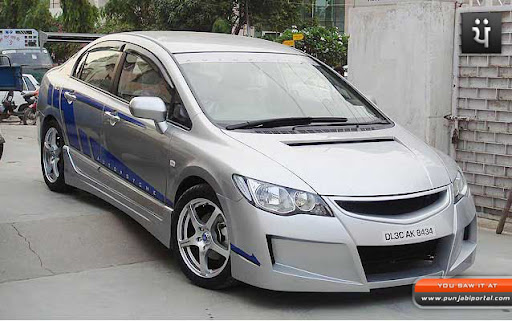
The first Honda City (AA for sedans, VF for vans and FA for the wider Turbo II and Cabriolets) was launched in November 1981 with the impressive "Tallboy" design; of unconventional height it allowed four adults to fit comfortably in the brief City (under 3.4 m or 11.2 feet). Produced as a 3-door hatchback in a variety of trim levels, the City was also available together with the Motocompo, a particular 50cc 'foldaway' scooter designed to easily fit into the City's small luggage area. On the right time of its launch, it was Honda's smallest car, while not being in conformity with Japanese Federal government kei regulations. It was longer than the Honda N360 by 383 millimetres (15.1 in), but shorter than the Honda Civic first technology by 171 millimetres (6.7 in).
The Honda City Turbo was presented in September 1982. It had been powered by way of a turbocharged version of the 1231 cc Honda ER engine. A Pininfarina designed drop-top Cabriolet implemented the wider fenders and bigger bumpers of the Turbo II "Bulldog", but was only normally available with the by natural means aspirated 67 PS (49 kW) engine. There was also a Pro-series of truck variations with either two or four seating. A high-roof "R Manhattan Roof" version with a 10 cm taller roof also appeared.
Exports of the City were mainly to European countries (where it was renamed Honda Jazz, credited to Opel having trademarked the City name), Australia (in two-seater 'truck' form, to circumvent Australian transfer restrictions on traveler vehicles at the time) and New Zealand (where it was locally built). Production ended in later 1986 with the introduction of the GA type City.
The fifth generation Honda City was revealed in Bangkok, Thailand in September 2008 accompanied by launches in India, Pakistan, Malaysia, Indonesia, Philippines, Singapore and China (Guangzhou Honda) in the following months. It really is manufactured in number of locations including Turkey, Thailand, Brazil and pakistan.
Based on market conditions, the populous city is available in a range of engine and specs levels. Generally in Asian markets the City will come in three variants - S, SV and v models. In a few market segments the SV and V is substituted by the E. For South America the range includes the DX, LX, EX, and EXL models.
The range of four-cylinder engines include a 1.3 producing 73 kW (98 horsepower) at 6,000 rpm, a 1.5 engine unit putting out 120 PS (88 kW), which both are available in manual and automatic transmissions (Indonesia) and a 1.8-liter R18A engine unit (China markets only).

In South America the range emerges with the i-VTEC 1.5-liter flex-fuel engine that is shared with the Brazilian Honda Fit. The charged ability end result is 115 horsepower with petrol and 116 horsepower using ethanol. Automatic and manual gearboxes are available.
In the Philippines, the 5th technology City was launched in '09 2009 available in 2 trims: 1.3 S and 1.5 E. The 1.3 liter is available in 5 acceleration manual or 5 rate automatic as the E variant is merely available in 5 swiftness automatic with paddle shifters.
The populous city was briefly offered in determined European countries including Poland with a 1.4-litre i-VTEC engine mated to the 5-speed manual or a 6-speed i-SHIFT automated manual transmission.
In November 2008 since it premiered in India, the town became the best-selling style of the business in the country, with sales amount even surpassing that of Thailand, previously the best selling market for the town. The Honda City has been the leader in the premium mid-sized sedan segment for a decade, with 35% market share this year 2010.
In 2009 February, Honda Australia have released the Thai-made City into the Australian market in two 1.5-litre variants (VTi and VTi-L). According to Honda Australia's boss, Yasuhide Mizuno, the City will compete with other light sedans including the Japanese built Toyota Yaris, the Korean-made Holden Barina and the Nissan Tiida (also Thai). This would be the first City released in Australia since the 1980s. It replaces the smaller-sized Civics previously.

The City premiered in 2011 in South Africa as the Ballade, to match below the Civic and above the Jazz (Fit) sold there.In 2011 September, Honda Automobile (Thailand) Ltd exposed the revamped Honda City, with new leading grille design, new front side and back bumpers, new taillamps design, new alloy rims, eco driving indication and dual entrance airbags to every model. The modified model premiered in India in December 2011 including five variants - Corporate, E, S, V and V (Sunroof) - and increased ground clearance to 165mm (recently 160mm) and also length increased by 20mm.Honda Automobiles Philippines launched the facelift version of the populous city in early 2012. It has a redesigned front grille, front and rear bumper and new alloy wheels for the 1.5 E variant, blue illumination measure and silver accent air conditioning change. In 2013, a new designed alloy wheels for both 1.3 and 1.5 variants and a color of the City has been changed Habanero Red has been substituted with Carnelian Red for the town. A Modulo version comes in both variants and in 2013 a Mugen version is designed for the 1.5 variant only.Honda Siel Autos India the Indian subsidiary of Honda Motors has launched the facelifted Honda City 2012 in India. The new Honda City 2012 premiered in India in seven variants. All variations are power by the same 1.5 litre i-VTEC petrol engine motor which offers 118PS of electric power with 146Nm of maximum torque. Also, the business was designed to kick off the Honda City diesel variants in the local market, that was launched in late 2012. This is actually the list of Honda City petrol models with the respective features.
http://www.honda-cirebon.netRelated Images with honda honda city luxury cars modified cars modified honda modified
honda luxury cars modified cars modified honda modified honda city

Tidak ada komentar:
Posting Komentar